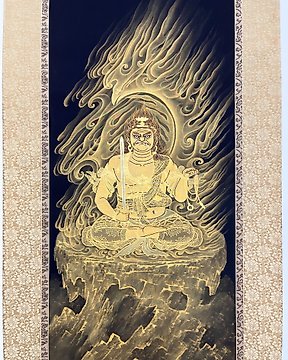
不動明王-Acalanāth, Achala Gold paint on black background, gold paint on navy blue paper, miniature - 春芳 - Japon
Nº 83004533

Nº 83004533

According to the Motobako(the original box), this painting is by master Kūkai 空海* at Nenbutsu-ji Temple化野念仏寺*. And collected by 開口神社(あぐちじんじゃ)* since 1868.
*空海Kukai (774 - April 22, 835 (March 21, 2012)) was a monk in the early Heian period. His posthumous name was Kobo Daishi. He is the founder of Shingon Buddhism. His common name is Saeki Mao (Saeki no Kare Hamao.
Along with Saicho, the founder of the Japanese Tendai sect, he was at the cusp of the transition of the majority of Japanese Buddhism from what is now called Nara Buddhism to Heian Buddhism, and brought Shingon Esoteric Buddhism from China. He was also a calligrapher and is considered one of the three great calligraphers, along with Emperor Saga and Issei Tachibana.
In Buddhism, esoteric Buddhism was born and developed within the Mahayana Buddhism, which is a major current of Northern Buddhism, incorporating the influence of Hinduism, and after it was transmitted to China via the Silk Road, the mysteries and sutras received in China ・He is also the person who brought mandalas and other works to Japan in a systematic form.
*Nenbutsu-ji Temple化野念仏寺
According to legend, in 811, Kukai buried the remains that had been left exposed in the field, buried 1,000 stone Buddhas for memorial services, erected a stone Buddha of Gochi Nyorai, and built Gochisan Nyorai-ji Temple. It is said that it begins even after doing so. Later, Honen opened a Nenbutsu dojo and the name was changed to Nenbutsu-ji Temple.
* 開口神社Opening Shrine (Aguchi Shrine)
In the 16th year of Tenpyo (744), Gyoki built Mitsujozan Nenbutsu-ji Temple, whose main image is Yakushi Nyorai, within the precincts, but over time, the syncretization of Shinto and Buddhism progressed, and it became our Jingu-ji Temple. In the Heian period, Nenbutsu-ji Temple became a temple of the Shingon sect due to the influence of Kukai, but it also has connections with Kuya, and became a thriving dojo for Esoteric Buddhism and Jodo Buddhism, and Nenbutsu-ji Temple came to be known as ``Great Temple.'' It has become established.
*毘沙門天``Bishamonten always protects Shaka Nyorai's dojo and listens to the Dharma, so he was named ``Tamonten,'' the man who hears many things.'' According to this explanation, Tamonten is a wise Buddha who knows many things. The Sanskrit word ``Vaishravana'', transliterated as ``Kunshamon'', also means ``listen all around''.
The Japanese think of Kunshamonten as a god of war, but in ancient Indian Brahmanism, Vaishravana was not considered a god of war, but a god of wisdom and a god who was clever and made money.
Material: Silk
Technique: Hand-painted
Roller ends: lacquered wood
Customs information
Shipping by Japan Post in a very fast delivery with tracking number.
Antique items have originally crease, stain, damage, and more.
And since this bolw set is hand paintined so I would like you to refer to the listing photos, but please understand that it's difficult to show all conditions by the photos.
Any other costs or charges such as customs or import duties,
customs clearance and handling may also apply during the shipment of your lot and will be charged to you by the involved party at a later stage if applicable.
Please understand!
Comment acheter sur Catawiki ?
1. Découvrez des objets d’exception
2. Faites la meilleure offre
3. Effectuez un paiement sécurisé